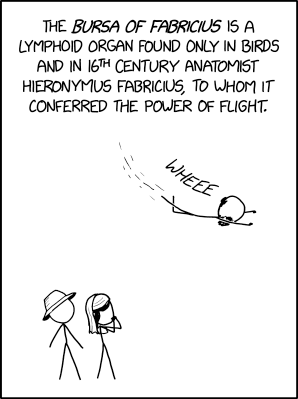The Bursa of Fabricius is an organ found in birds that is necessary for the development of their immune systems.
This comic claims that the 16th century anatomist Hieronymus Fabricius (for whom the organ was named) had that organ and therefore was able to fly like a bird. However, despite being found only in birds, this organ does not in fact contribute directly to flight. Also, given that it only exists in birds, it is doubtful that Fabricius also independently had this same anatomical feature.
Many scientific and mathematical discoveries, including anatomical structures, are named after the people who discovered or described them. For example, the islets of Langerhans were discovered by Paul Langerhans. Likewise, rare diseases are often named for the doctor who first describes the disease to the medical community, or for a researcher who identifies the specifics involved. They may attempt to set their own name to it, for posterity, or they are later honored in this manner by those who recognize their vital contribution to the field, such as with Parkinson's disease.
In other cases, rare diseases are named for the first or most famous (possibly even the only) person known to have had the disease. For instance ALS is commonly known as Lou Gehrig's disease in the US because of baseball player Lou Gehrig having notably developed the condition. Outside of the US, it may be more known just as "amyotrophic lateral sclerosis" (alternatively "motor neurone disease") or, for simplicity, the initials ALS (or MND).
The title text continues with the idea from the comic claiming that anatomical structures are solely possessed by the human for which they are named, in another similar example. Pierre Paul Broca, a French physician, anatomist and anthropologist, was known for his research on what is now known as Broca's area, a region of the brain used for speech and language processing. The premise being that, having this feature, he was uniquely gifted with the special ability to created powerful magnetic fields, enabling him to do fMRI research in the 19th century. Later in the same year, Broca was again referenced in 2780: Physical Quantities.
Broca did not do fMRI research, a powerful method of non-intrusively imaging and analyzing the internal structures of the living human body (amongst other things), as it was not invented in his lifetime. Nor is it likely that this ability could be 'naturally' possessed by any individual, such as he. He did, however, physically study brains of known speech-impaired patients who had then subsequently died, determining what damage (in the area of the brain which was then to be named for him) was directly related to their specific group of ailments. Today, we can safely view this area in living people, using fMRI, and directly connect what we see with the current condition of patients. This increases our knowledge of the brain, as with the mythical abilities Randall gave Broca, but also possibly even allows us to help those currently under the effects of any observed damage (not necessarily possible by any 19th century physician, even with this superpowered form of vision to assist them).
In reality, if Broca was the only person to have ever possessed Broca's area then this might have meant that only he had ever had the power of speech (as we understand it), which would indeed give him a very special ability; but one begging a number of other vital questions, if only anybody else could have asked them...
